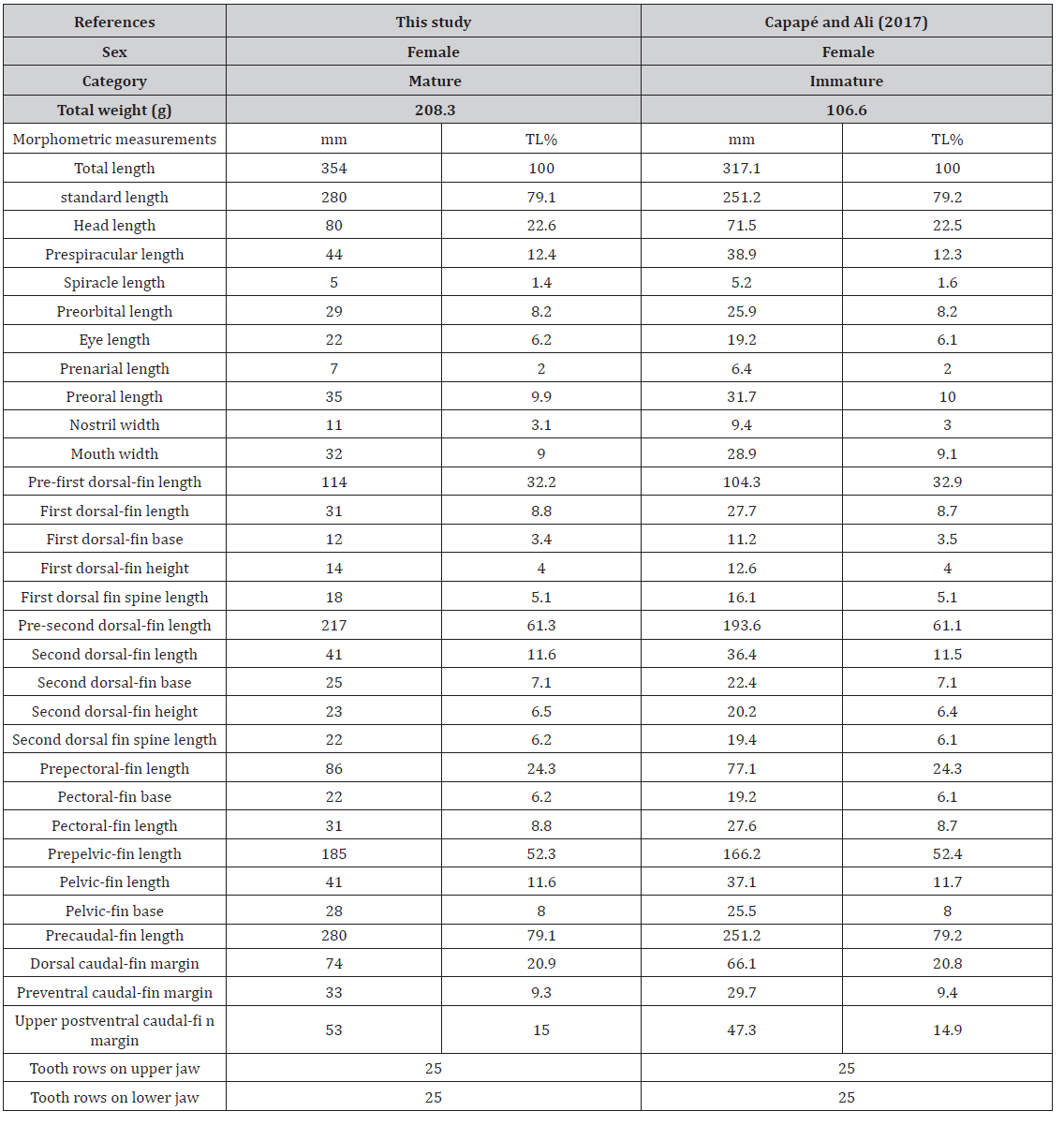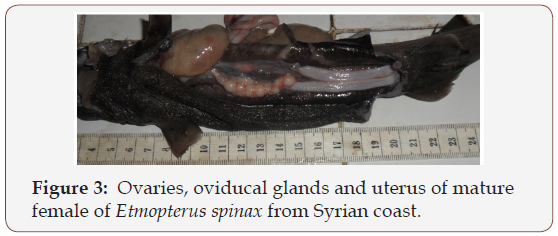 Case Report
Case Report
Occurrence of Mature Female of Etmopterus Spinax (Chondrichthyes: Etmopteridae) in the Syrian Coast (Eastern Mediterranean)
Adib Saad, Tishreen University, Lattakia, Syria.
Received Date: August 25, 2018; Published Date: Septembert 21, 2018
Abstract
Velvet Belly Lantern shark, Etmopterus spinax (Linnaeus, 1758) is recorded for second time in the Syrian coast. A mature female of E. spinax measured 354mm total length, and weighed 208.3g, caught at depth about 300m. the specimen was in stage 3, had two ovaries; contained 9 oocytes measured between 10-5mm in diameter. The width of left and right oviducal gland measured; 8mm and 7mm, respectively. It had left and right functional uterus, white color measured; 77mm and 75mm in length; 11mm and 10 mm in width, respectively.
Keywords: Velvet belly lantern shark; Second record; Maturing, Syrian coast
Introduction
The velvet belly Etmopterus spinax (Linnaeus, 1758) is a smallsized deep-water squaliform. Although E. spinax is known to be more commonly caught in the western Mediterranean Basin [1,2]; mainly off the Tunisian and Sicilian coasts [3,4], the species is reported in both Mediterranean Basins in waters ranging between 150-200 m and 400 m, and probably deeper [5]. It has been recorded at depths as low as 2,200 m in the Ionian Sea [6]. The species is reported in the Aegean Sea [7], in Turkish waters [8], off the Egyptian coast [9], and in the Levant Basin [10,11]. Conversely, the species is not recorded off the Lebanese coast [12]. This paper is reporting second occurrence of E. spinax from Syrian marine waters and providing for the first time the principal biometric and meristic characters, and some remarks on biology of this species in the eastern Mediterranean.
Materials and methods
On 19 October 2017, mature female of E. spinax (Linnaeus, 1758) was caught in Syrian marine waters by trawl as far as the city of Jableh (between 35° 26´ N, 35° 43´ E) at a depth of about 300 m, on sandy and muddy bottoms (Figure 1). All measurements were recorded to the nearest 1 mm and weighted to the nearest 0.1 gram. The description of the specimens in the present paper follows Bello et al. [13] and Capapé & Ali [11. Stage of maturity was determined following the scales for viviparous Elasmobranchs proposed by Anonymous [12].

Results
The female of E. spinax (Figure 2) measuring 354 mm and weighing 208.3 g total weight. Body robust with a fairly long tail, snout moderately long, broad and flattened, both dorsal fins bearing stout, grooved spines at the front, with the second fi n much longer than the first and curved; mouth with thin, smooth lips; upper teeth small with a narrow central cusp and two pairs of lateral cusp lets; lower teeth larger with a strongly slanted, bladelike cusp at the top and interlocking bases; five pairs of tiny gill slits, comparable in size to spiracles; first dorsal fin originating behind short and rounded pectoral fins; second dorsal fin larger than the first and originating behind the pelvic fins; anal fin absent; tail slender, leading to a long caudal fin with a small lower lobe and a low upper lobe with a prominent ventral notch near the tip; coloration brown above, abruptly transitioning to black below; black markings on flanks above and behind the pelvic fins, and along the caudal fin.

Morphometric data of the specimen are summarized in Table 1. The specimen was a mature female, stage 3, has two ovaries; contained 9 oocytes measured between 10-5 mm in diameter and a large number of small oocytes ≤ 2mm, the oviducal glands were simple and barrel shaped with no lateral extensions, the width of left and right oviducal gland measured; 8mm and 7mm, respectively. In addition, it had left and right functional uterus, white color measured; 77mm and 75mm in length; 11mm and 10mm in width, respectively (Figure 3) The stomach of the specimen was empty.
Morphometric characteristics of the specimen of Etmopterus spinax (mature female) from the coast of Syria and compared with similar data previously recorded in specimen caught off the Syrian coast. Measurements are given as (mm) and as percentage value of TL (%).
Table 1: Morphometric characteristics of the specimen of Etmopterus spinax (mature female) from the coast of Syria and compared with similar data previously recorded in specimen caught off the Syrian coast. Measurements are given as (mm) and as percentage value of TL (%).


Discussion
The measurements count and colour are in total agreement with previous descriptions of E. spinax by Compagno LGV [13], Mc Eachran JD &Branstetter S [16] and Capapé & Ali [11].
From Syrian coast, three immature females were recorded, measured 298.6mm, 306.3mm and 317.1mm in TL, respectively, and weighing 102.3g, 110.4g and 106.6g, respectively. These specimens were first records of the species by Capapé & Ali [11]. Records of immature and mature specimens of the species could suggest that a probable E. spinax population is established in the area. However, such a hypothesis needs further confirmation.
E. spinax is an aplacental viviparous species with two uteri and both left and right ovaries are functional. The characters of ovaries, oviducal glands and uterus are in agreement with results of Porcu et al. [4] a bout mature females’ aspect. Females with ripe oocytes ready to be ovulated were observed in August and in October; their uteri were in a resting phase, TL50 = 38 cm for females and ovarian fecundity between 5 and 17 from Tunisian coasts [3]. In addition, Vacchi & Relini Oris [17] noted that spawning season from February-November, TL50 = 34 cm for females, ovarian fecundity from 5 to 14 in Ligurian Sea. Whereas Spawning season was in all year Sardinian waters, TL50 =36.9 cm for females and fecundity between 6 and 27. Sexual maturity is reached at similar sizes specimens from the previous studies, also number of oocytes is filled into the range of ovarian fecundity of the species. However, a large number of the species individuals are needed to determine the TL50, and the ovarian and uterus fecundity in Syrian marine waters.
This record of E. spinax could confirm the occurrence of this species in the Levant Basin, and increase its distribution along the Syrian coast.
References
- Capapé C (1989) Les Sélaciens des côtes méditerranéennes: aspects généraux de leur écologie et exemples de peuplements = Selachians off the coasts of the Mediterranean: general characters of their ecology and examples of populations. Océanis 15(3): 309-331.
- Capapé C, Tomasini JA, Quignard JP (2000) Les elasmobranches pleurotrêmes de la côte du languedoc (France méridionale, méditerranée septentrionale). Observations biologiques et démographiques. Vie Milieu 50 (2): 123-133.
- Capapè C, Bradai MN, Seck AA, Diatta Y, Tomasini JA, et al. (2001) Aspects of the reproductive biology of the velvet belly, Etmopterus spinax (Elasmobranchii: Squalidae). Bulletin de l’Institut des Sciences et Technologies de la Mer de Salammbô 28 : 55-63.
- Porcu C, Marongiu M, Follesa M, Bellodi A, Mulas A, et al. (2013) Reproductive aspects of the velvet belly lantern shark Etmopterus spinax (Condrichthyes: Etmopteridae), from the central western Mediterranean Sea. Notes on gametogenesis and oviducal gland microstructure. Mediterranean Marine Science 15(2): 313-326.
- Quignard JP, Capapé C (1971) Commented list of the Selacians of Tunisia. Bull Inst nat Océanogr Pêche, Salammbô 2(2): 131-141.
- Sion L, Bozzano A, D’Onghia G, Capezzuto F, Panza M (2004) Chondrichthyes species in deep waters of the Mediterranean Sea. Scient Mar 68 (Suppl 3): 153-162.
- Bello G, Causse R, Lipej L, Dulcic J (2014) A proposed best practice approach to overcome unverified and unverifiable “first records” in ichthyology/ proposition d’un protocole precis pour eviter les premiers signalements non verifies et non verifiables en ichtyologie. Cybium 38(1): 9-14.
- Bilecenoğlu M, Kaya M, Cihangir B, Çicek E (2014) An updated checklist of the marine fishes of Turkey. Turk J Zool 38(6) : 901-929.
- Farrag MMS (2016) Deep-sea ichthyofauna from Eastern Mediterranean Sea, Egypt: Update and new records. Egypt J aquat Res 42(4): 479-489.
- Golani D (2005) Check-list of the Mediterranean Fishes of Israel. Zootaxa 947(1): 1-200.
- Capapé C, Ali M (2017) First record of velvet belly lantern shark Etmopterus spinax (Chondrichthyes: Etmopteridae) from the Syrian coast (eastern Mediterranean). Annales Ser. hist. nat. 27 (2): 145-150.
- Mouneimne M (1979) Poissons nouveaux pour les côtes libanaises. Cybium 6: 105-110.
- Bello G, Causse R, Lipej L, Dulcic J (2014) A proposed best practice approach to overcome unverified and unverifiable “first records” in ichthyology/ proposition d’un protocole precis pour eviter les premiers signalements non verifies et non verifiables en ichtyologie. Cybium 38(1): 9-14.
- Anonymous (2010) Report of the workshop on sexual maturity staging of elasmobranches (WKMSEL), Valetta, Malta.
- Anonymous (2010) Report of the workshop on sexual maturity staging of elasmobranches (WKMSEL), Valetta, Malta.
- Mc Eachran J.D. & Branstetter S. 1984. Squalidae. In: P.J.P. Whitehead, M.L. Bauchot, J.C. Hureau., J. Nielsen J., Tortonese. E. (Eds), pp. 128- 147. Fishes of the North-western Atlantic and the Mediterranean, Vol I, UNESCO, Paris.
- Vacchi M, Relini Orsi L (1979) Aspetti riproduttivi in Etmopterus spinax L. (Chondrichthyes, Squalidae). Quaderni della Civica Stazione Idrobiologica di Milano 7: 64-74.
-
Adib Saad, Hasan Alkusairy. Occurrence of Mature Female of Etmopterus Spinax (Chondrichthyes: Etmopteridae) in the Syrian Coast (Eastern Mediterranean). Ad Oceanogr & Marine Biol. 1(1): 2018. AOMB.MS.ID.000504.
-
Chondrichthyes, Etmopteridae, Mediterranean, Etmopterus, Linnaeus, Oviducal, Velvet, Belly, Squaliform, Mediterranean, Viviparous, Elasmobranchs, Anonymous, Morphometric, Prespiracular, Spiracle, Preorbital, Prenarial, Nostril, Pectoral, Pelvic, oviducal, Syrian
-

This work is licensed under a Creative Commons Attribution-NonCommercial 4.0 International License.






